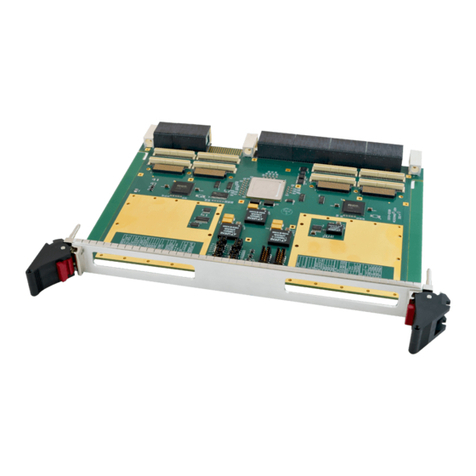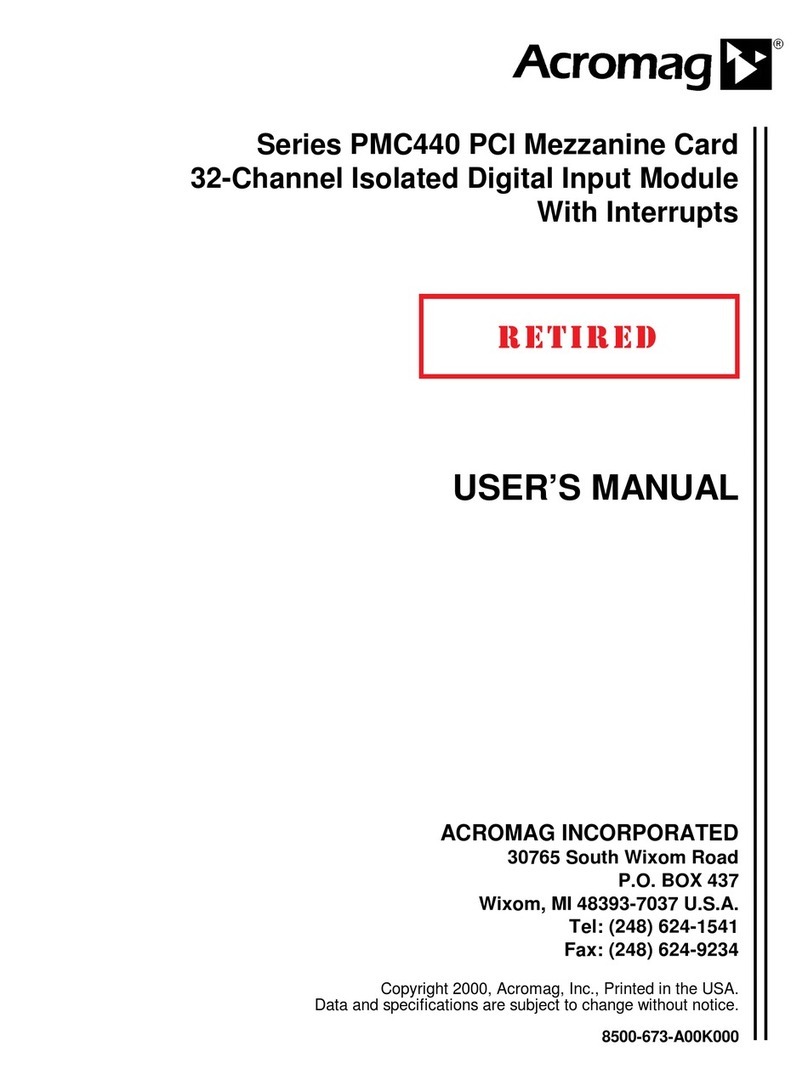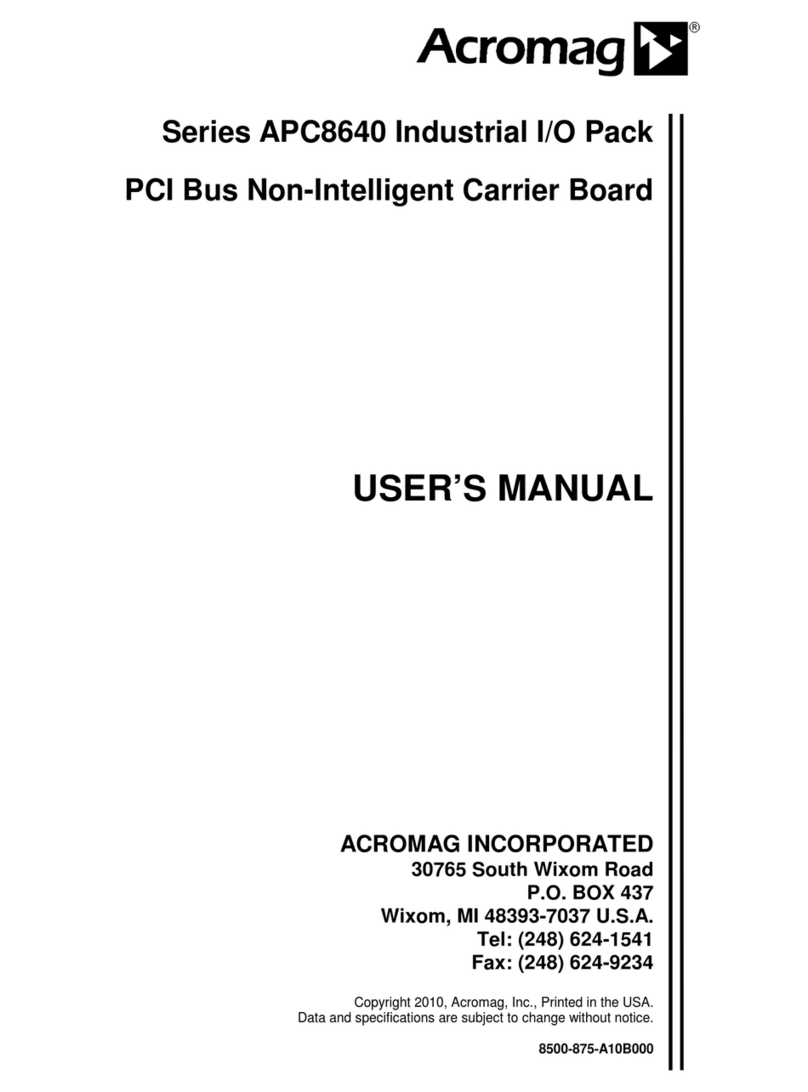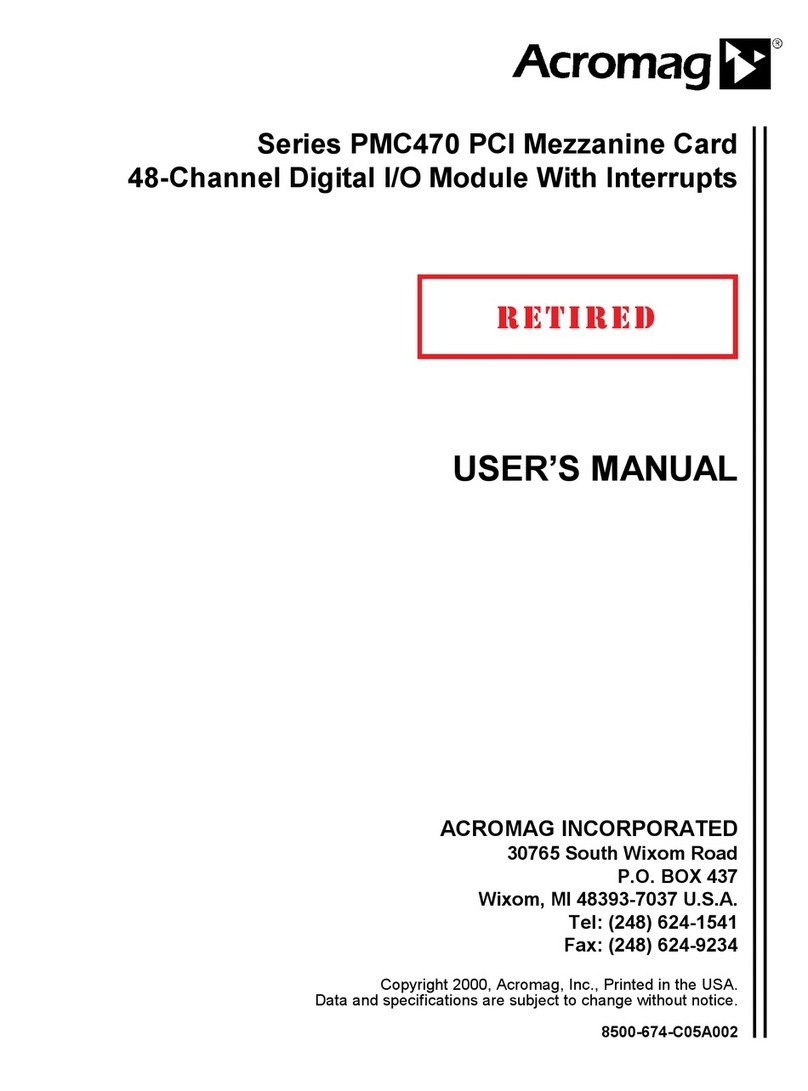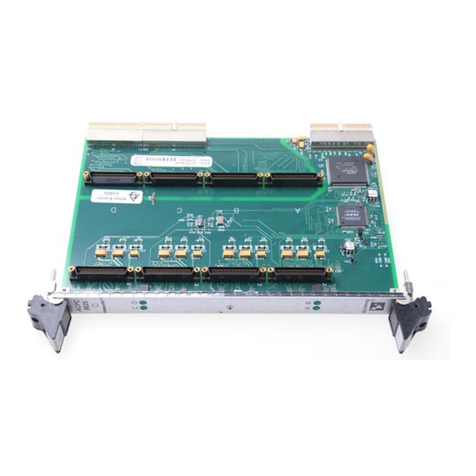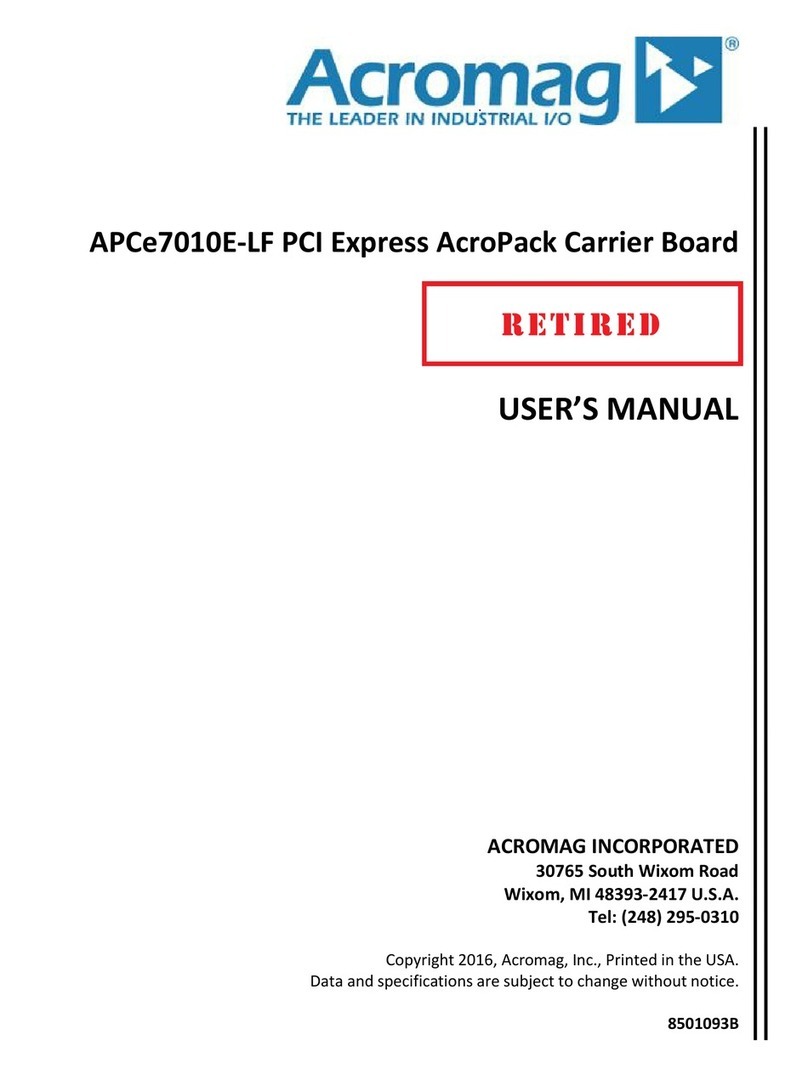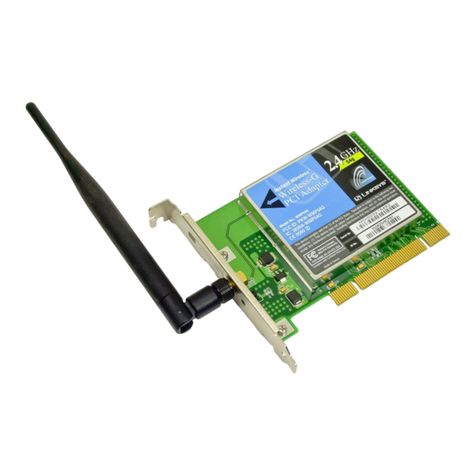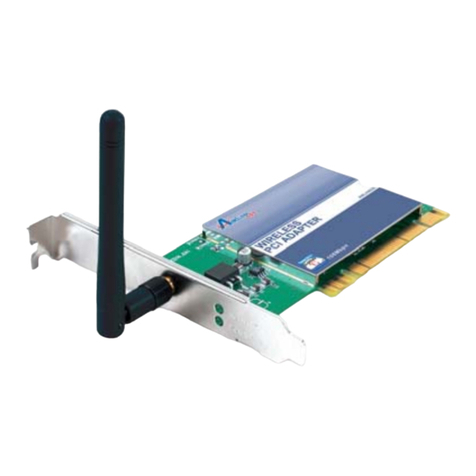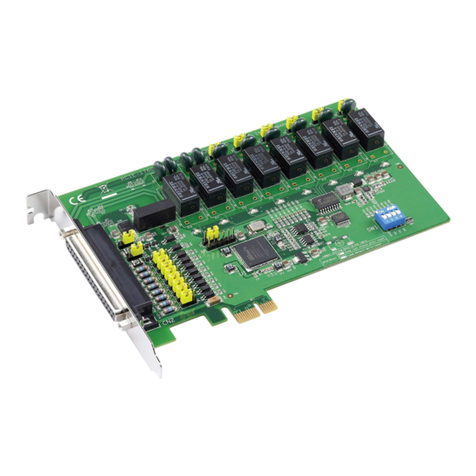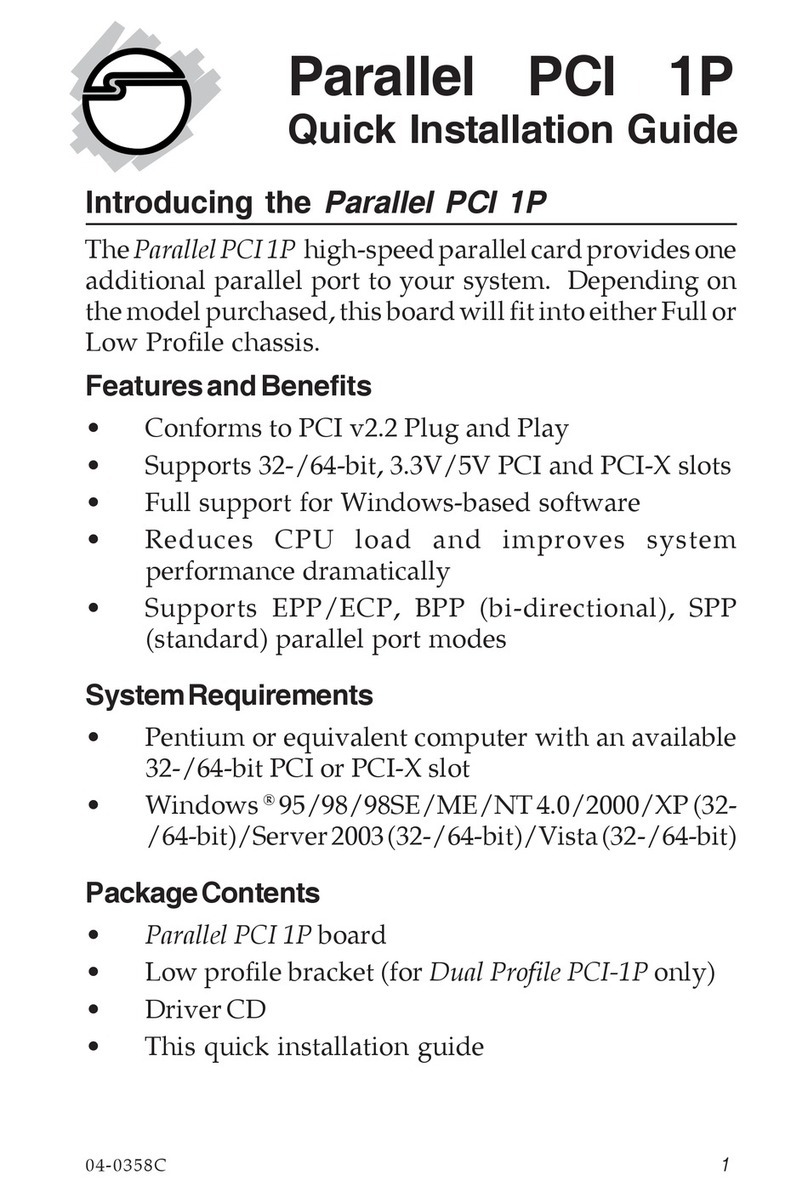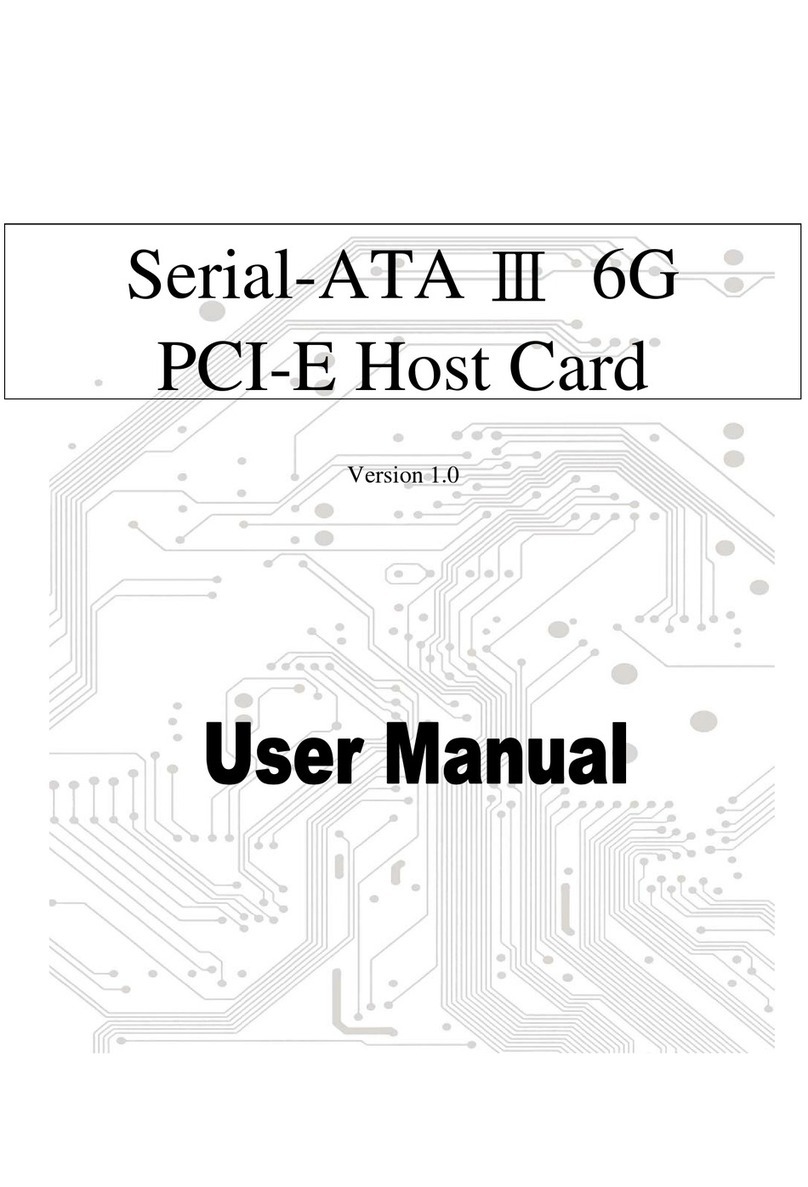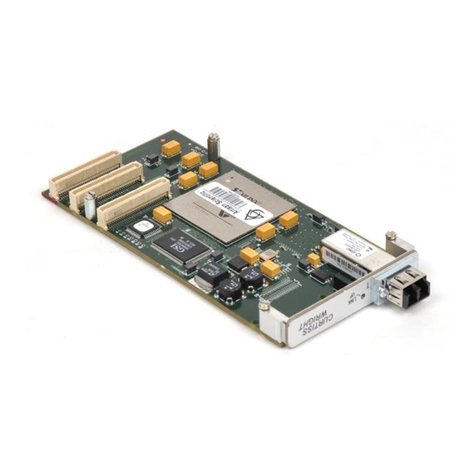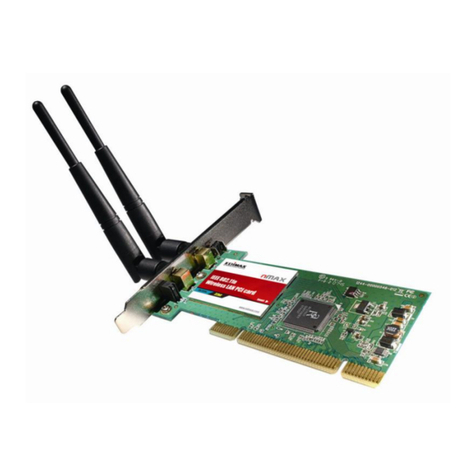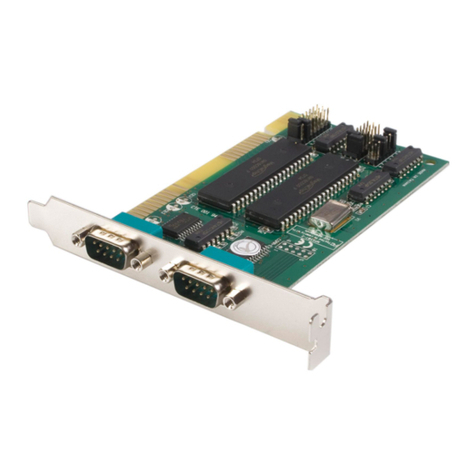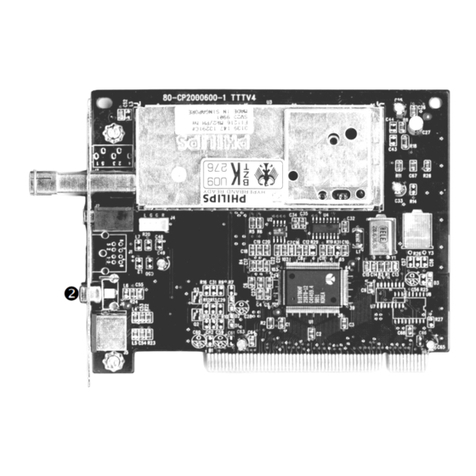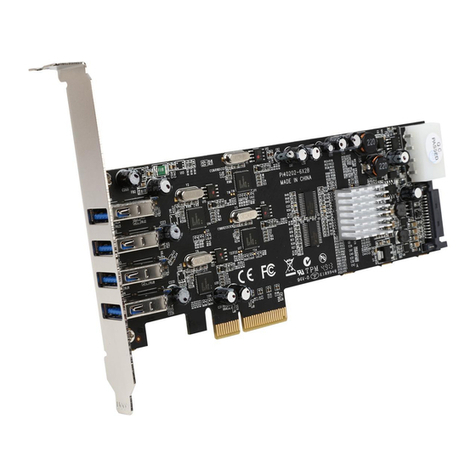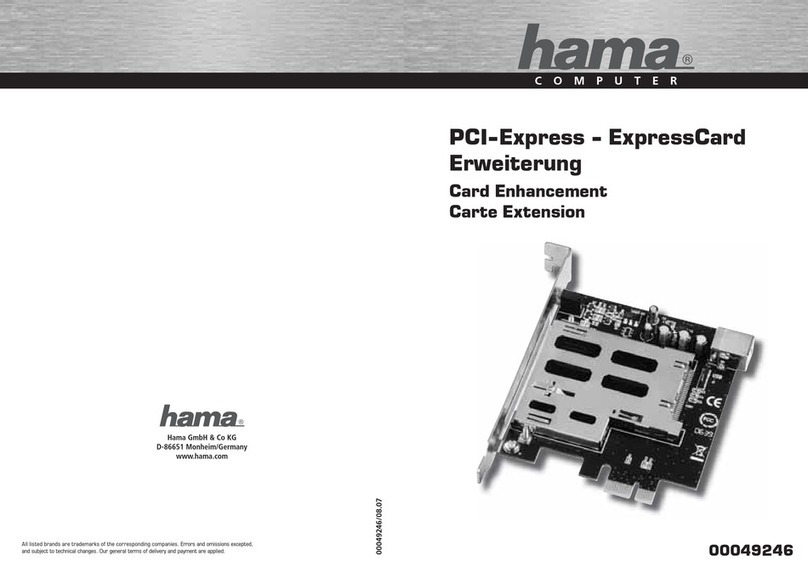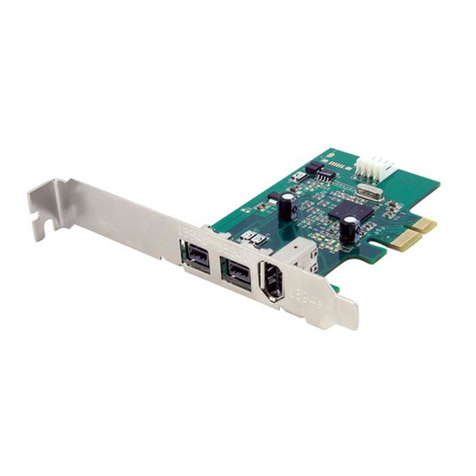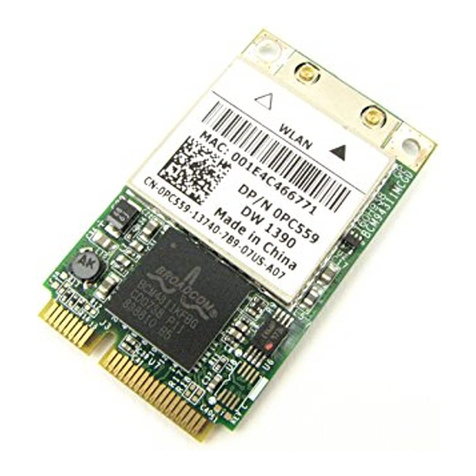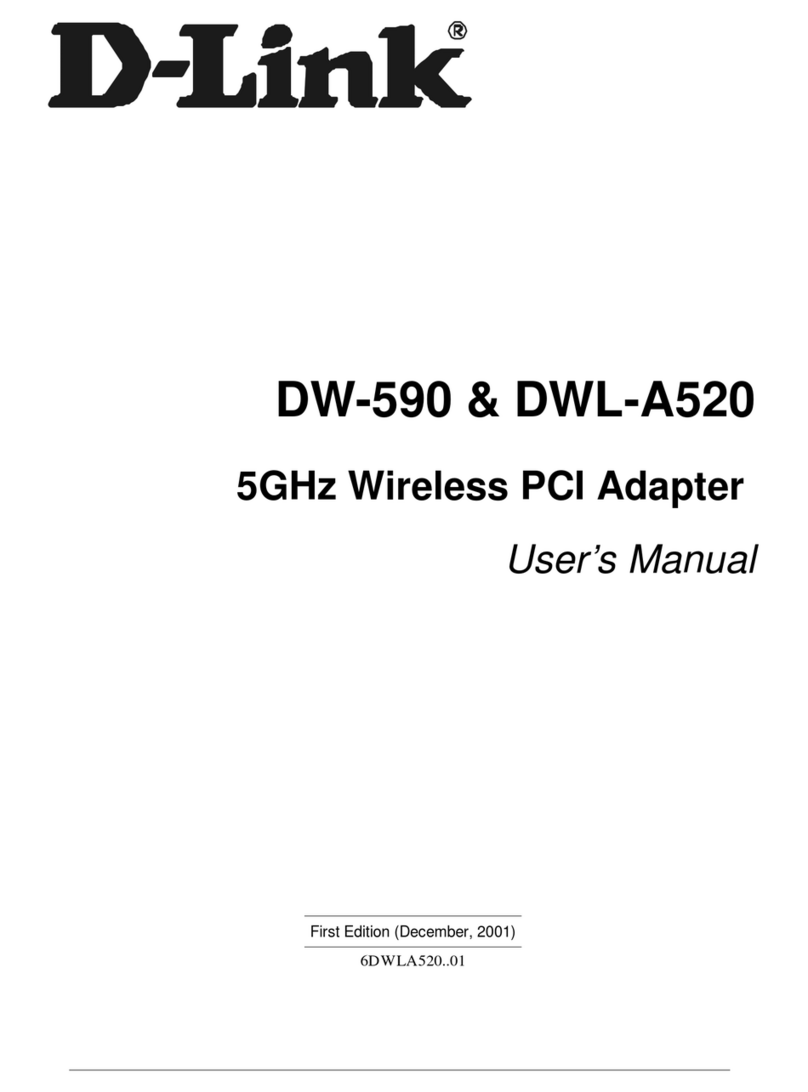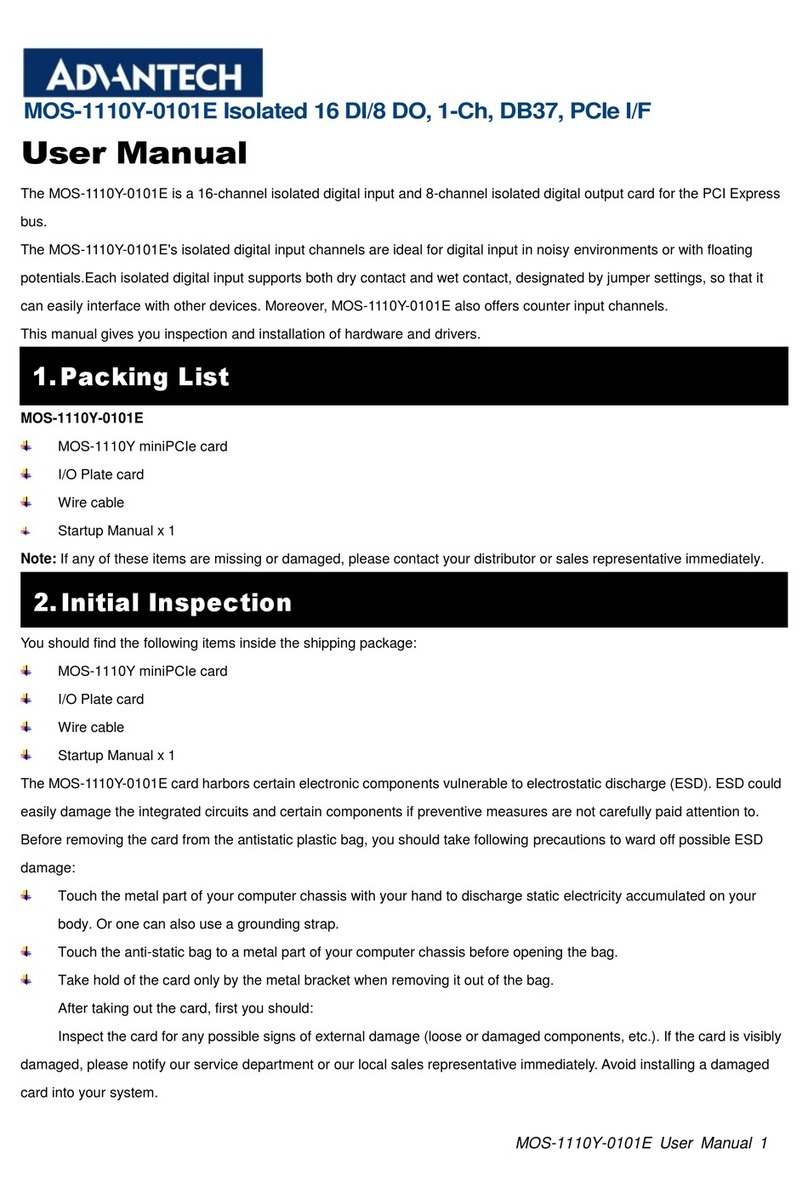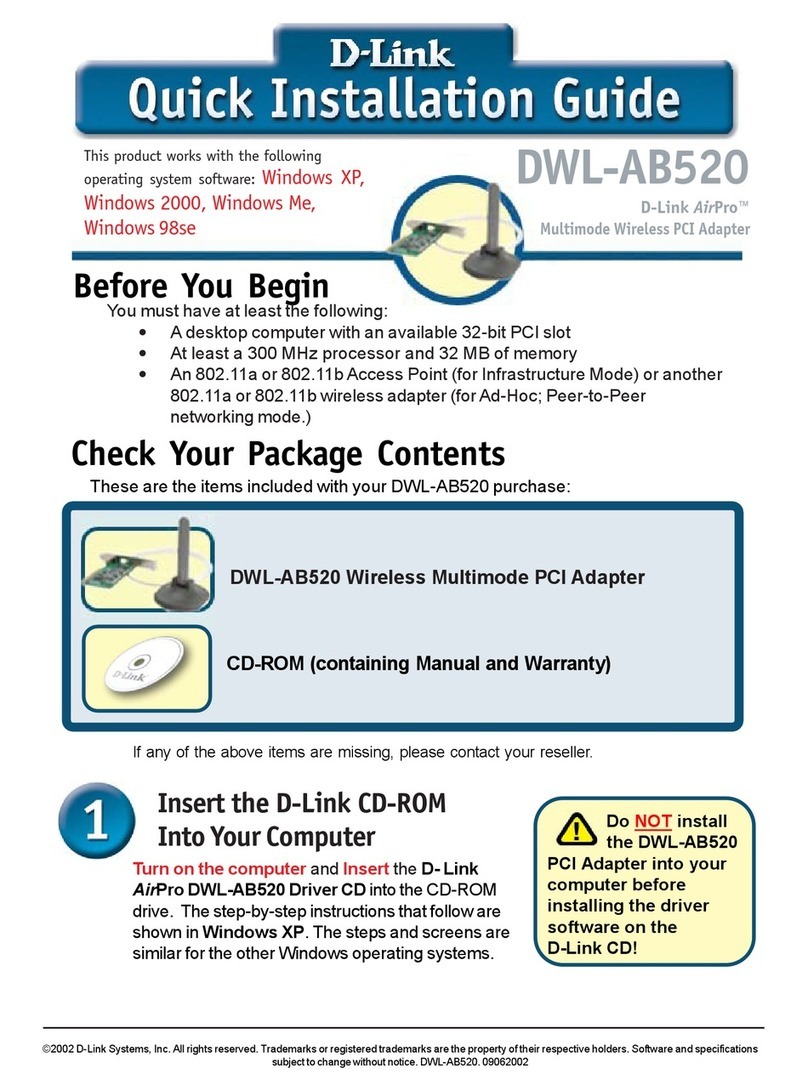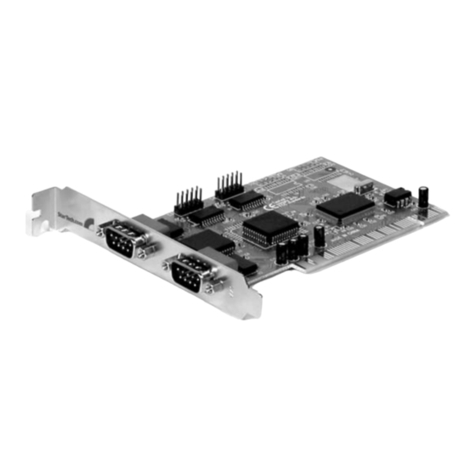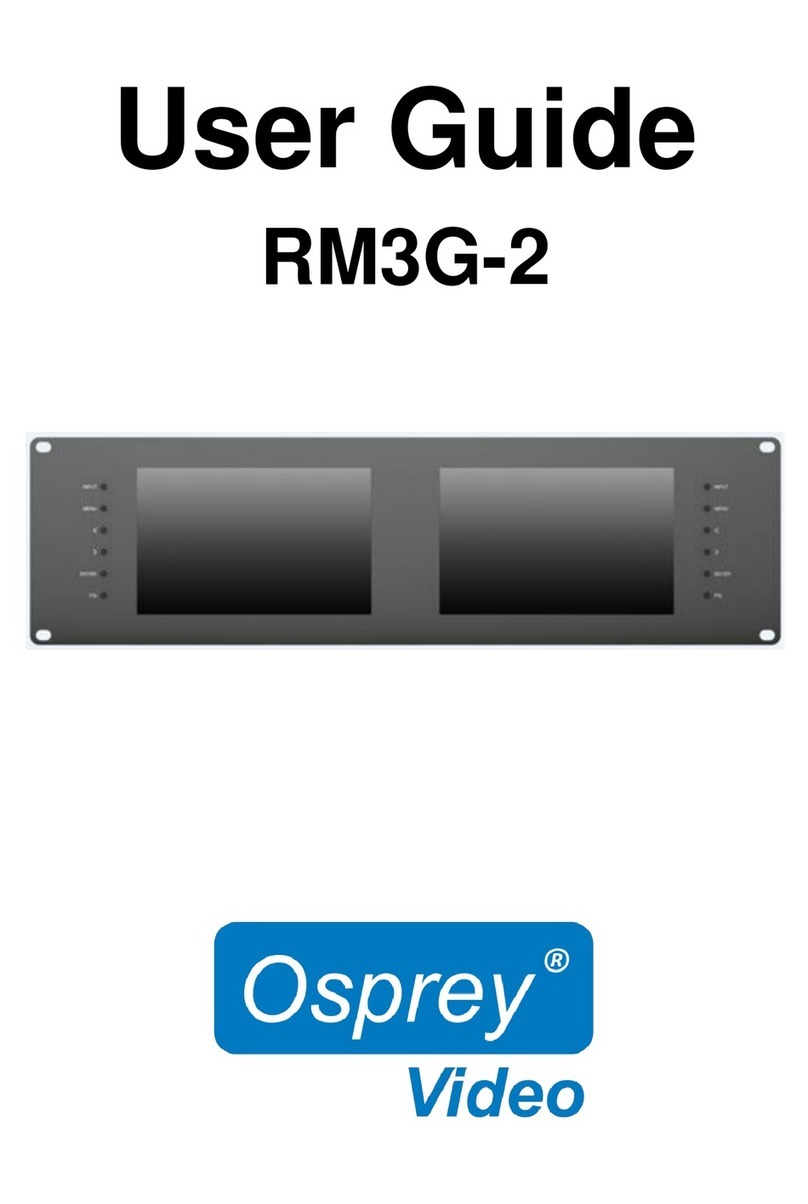Acromag PMC408 Series User manual

Artisan Technology Group is your source for quality
new and certied-used/pre-owned equipment
• FAST SHIPPING AND
DELIVERY
• TENS OF THOUSANDS OF
IN-STOCK ITEMS
• EQUIPMENT DEMOS
• HUNDREDS OF
MANUFACTURERS
SUPPORTED
• LEASING/MONTHLY
RENTALS
• ITAR CERTIFIED
SECURE ASSET SOLUTIONS
SERVICE CENTER REPAIRS
Experienced engineers and technicians on staff
at our full-service, in-house repair center
WE BUY USED EQUIPMENT
Sell your excess, underutilized, and idle used equipment
We also offer credit for buy-backs and trade-ins
www.artisantg.com/WeBuyEquipment
REMOTE INSPECTION
Remotely inspect equipment before purchasing with
our interactive website at www.instraview.com
LOOKING FOR MORE INFORMATION?
Visit us on the web at www.artisantg.com for more
information on price quotations, drivers, technical
specications, manuals, and documentation
Contact us: (888) 88-SOURCE | sales@artisantg.com | www.artisantg.com
SM
View
Instra

Series PMC408 PCI Mezzanine Card
32-Channel Digital I/O Module
USER’S MANUAL
ACROMAG INCORPORATED
30765 South Wixom Road
P.O. BOX 437
Wixom, MI 48393-7037 U.S.A.
Tel: (248) 624-1541
Fax: (248) 624-9234
Copyright 2000, Acromag, Inc., Printed in the USA.
Data and specifications are subject to change without notice.
8500-672-B03E011

SERIES PMC408 PCI MEZZANINE CARD 32-CHANNEL DIGITAL I/O MODULE
___________________________________________________________________________________________
- 2 -
The information contained in this manual is subject to change
without notice. Acromag, Inc. makes no warranty of any kind with
regard to this material, including, but not limited to, the implied
warranties of merchantability and fitness for a particular purpose.
Further, Acromag, Inc. assumes no responsibility for any errors that
mayappear in this manual and makes no commitment to update, or
keep current, the information contained in this manual. No part of
this manual may be copied or reproduced in any form, without the
prior written consent of Acromag, Inc.
Table of Contents Page
1.0 GENERAL INFORMATION............................................... 2
KEY PMC408 FEATURES................................................ 2
PCI MEZZANINE CARD INTERFACE FEATURES......... 3
SIGNAL INTERFACE PRODUCTS.................................. 3
PMC MODULE ActiveX CONTROL SOFTWARE............ 3
PMC MODULE VxWORKS SOFTWARE……….............. 3
2.0 PREPARATION FOR USE................................................ 3
UNPACKING AND INSPECTION..................................... 3
CARD CAGE CONSIDERATIONS................................... 4
BOARD CONFIGURATION.............................................. 4
CONNECTORS................................................................. 4
Front Panel Field I/O Connector P1............................... 4
I/O Noise and Grounding Considerations....................... 4
Output Off-State Loading Considerations...................... 4
PCI Local Bus Connector ........................………........... 4
3.0 PROGRAMMING INFORMATION.................................... 5
PCI CONFIGURATION ADDRESS SPACE……...……... 5
CONFIGURATION REGISTERS……………...………….. 6
MEMORY MAP….............................................................. 6
Interrupt Register………................................................ 6
IP Digital Input Registers A & B..................................... 6
IP Digital Output Registers A & B.................................. 7
Interrupt Enable Register............................................... 7
Interrupt Type Configuration Register............................ 7
Interrupt Polarity Register............................................... 7
Interrupt Status Register................................................ 8
PMC408 PROGRAMMING CONSIDERATIONS............. 8
Programming Interrupts................................................ 8
4.0 THEORY OF OPERATION............................................... 9
INPUT/OUTPUT................................................................ 9
PCI INTERFACE LOGIC…............................................. 9
PMC MODULE SOFTWARE............................................ 10
5.0 SERVICE AND REPAIR.................................................... 10
SERVICE AND REPAIR ASSISTANCE........................... 10
PRELIMINARY SERVICE PROCEDURE......................... 10
6.0 SPECIFICATIONS............................................................. 10
PHYSICAL……………………............................................ 10
ENVIRONMENTAL…………………………………………. 10
DIGITAL INPUTS.............................................................. 11
DIGITAL OUTPUTS.......................................................... 11
OUTPUT MOSFETS......................................................... 11
PCI LOCAL BUS INTERFACE…………........................... 11
APPENDIX......................................................................... 12
CABLE, SCSI-2 to Flat Ribbon (Shielded):
MODEL 5028-187………...................................................
12
TERMINATION PANEL: MODEL 5025-552..................... 12
DRAWINGS Page
4501-859 PMC MECHANICAL ASSEMBLY..............…... 13
4501-866 PMC408 BLOCK DIAGRAM............................ 14
4501-867 PMC408 EXAMPLE OUTPUT
CONNECTIONS………………………………...
15
4501-868 PMC408 EXAMPLE INPUT
CONNECTIONS………………………………..
16
4501-758 CABLE, SCSI-2 to Flat Ribbon (Shielded)
5028-187…..………………..............................
17
4501-464 TERMINATION PANEL 5025-552................... 18
IMPORTANT SAFETY CONSIDERATIONS
It is very important for the user to consider the possible adverse
effects of power, wiring, component, sensor, or software failures in
designing any type of control or monitoring system. This is
especially important where economic property loss or human life is
involved. It is important that the user employ satisfactory overall
system design. It is agreed between the Buyer and Acromag, that
this is the Buyer's responsibility.
1.0 GENERAL INFORMATION
The PCI Mezzanine Card (PMC) Series PMC408 is a 32-
channel combination digital input/output board. This model supports
both 0 to 60V DC inputs, and 60VDC low-side switch outputs, in any
combination up to 32 channels. As a combination input/output
module, input channels on this model can be used for “loopback”
monitoring of the output channel states. Up to 8 input channels can
be programmed to generate Change-Of-State (COS), Low, or High
level transition interrupts. The PMC408 utilizes state of the art
Surface-Mounted Technology (SMT) to achieve its high channel
density and is an ideal choice for a wide range of industrial control
and monitor applications that require high-density, high-reliability,
and high-performance at a low cost.
The PMC408 module is available in standard and extended
temperature ranges as follows;
MODEL OPERATING TEMPERATURE RANGE
PMC408 0 to +70°C
PMC408E -40 to +85°C
KEY PMC408 FEATURES
•
High Channel Count - Interfaces with up to 32 input/output
points. Input and output channels may be intermixed in any
combination. The input circuitry of a single channel can also
be used to monitor the output state of the same channel to
efficientlyimplement “loopback” output control.
•
TTL-Compatible Input Threshold - Input threshold is at TTL
levels and includes hysteresis.
•
Input Hysteresis - Buffered inputs include hysteresis for
increased noise immunity.
•
Programmable Change-of-State/Level Interrupts -
Interrupts are software programmable for any bit Change-Of-
State or level on up to 8 channels.
•
Loopback Output Control & Fault Diagnostics - Input and
output circuitry is connected in tandem to each I/O channel,
making it directly compatible for “loopback monitoring” of the
output channel states. This feature can also be used to

SERIES PMC408 PCI MEZZANINE CARD 32-CHANNEL DIGITAL I/O MODULE
___________________________________________________________________________________________
- 3 -
implement self-test or fault diagnosis, since inherent loopback
can be used to detect open output switches or shorts.
•
High Voltage Inputs & Outputs - Inputs and outputs are
rated to 60VDC. I/O channels are non-isolated and share a
common connection.
•
High Impedance Inputs - High impedance inputs minimize
loading of the input source and input current.
•No Configuration Jumpers or Switches - All configuration is
performed through software commands with no internal
jumpers to configure or switches to set.
•
Power Up & System Reset is Failsafe - For safety, the
outputs are always OFF upon power-up and cleared after a
system reset. Unlike some competitive units, output gate
pulldowns are included to ensure that the outputs do not turn
on momentarily when output load power is applied with no
power to the IP module.
•
True Logic - Outputs operate using True-Logic
(1=ON/SWITCH CLOSED, 0=OFF/SWITCH OPEN).
•
Low R
dsON
(0.2ΩMaximum)- Low output drain-to-source ON
resistance ensures TTL logic-low compatibility at high currents
and reduces power dissipation.
•
High Output Current - individual output channels may sink up
to 1A DC continuous (up to 10A total, all channels combined),
or 312mA DC (with all 32 channels ON). No deration of
maximum output current is required at elevated ambient
temperatures.
PCI MEZZANINE CARD INTERFACE FEATURES
•
High density - Single-width PMC Target module.
•
Field Connections – All digital inputs/outputs (channels 0 –
31) and common connections are made through a single 50-pin
SCSI-2 front panel I/O connector.
•
16-bit I/O - Channel register Read/Write is performed through
through 32-bit, 16-bit or 8-bit data transfer cycles in the PCI
memory space.
•
Compatibility – IEEE P1386.1 compliant PMC module which
complies to PCI Local Bus Specification Revision 2.2.
Provides one multifunction interrupt. 5V signaling compliant
and 3.3V signaling tolerant.
SIGNAL INTERFACE PRODUCTS
(See Appendix for more information on compatible products)
This PMC Module will mate directly to any standard PMC
carrier/CPU board that supports one single width PMC mezzanine
module. Once connected, the module is accessed via a 50 pin front
panel connector.
The cables and termination panels, described in the following
paragraphs, are also available. For optimum performance with the
PMC408 digital I/O module, use of the shortest possible length of
shielded I/O cable is recommended.
Cables:
Model 5025-187 (SCSI-2 to Flat Ribbon Cable, Shielded): A
round 50 conductor shielded cable with a male SCSI-2
connector at one end and a flat female ribbon connector at the
other end. The cable is used for connecting the PMC408
moduleto Model 5025-552 termination panels.
Termination Panel:
Model 5025-552: DIN-rail mountable panel provides 50 screw
terminals for universal field I/O termination. Connects to
Acromag PMC408, via SCSI-2 to Flat Ribbon Cable, Shielded
(Model 5028-187).
PMC MODULE ActiveX CONTROL SOFTWARE
Acromag provides a software product (sold separately)
consisting of PMC module ActiveX (Object Linking and Embedding)
controls for Windows 98, 95®, ME, 2000 and Windows NT®
compatible application programs (Model PMCSW- ATX, MSDOS
format). This software provides individual controls that allow
Acromag PMC modules to be easily integrated into Windows®
application programs, such as Visual C++™, Visual Basic®,
Microsoft®Office®97 applications and others. The ActiveX
controls provide a high-level interface to PMC modules, eliminating
the need to perform low-level reads/writes of registers, and the
writing of interrupt handlers—all the complicated details of
programming are handled by the ActiveX controls. These functions
consist of an ActiveX control for each Acromag PMC module.
PMC MODULE VxWORKS SOFTWARE
Acromag provides a software product (sold separately)
consisting of PMC module VxWorks®libraries. This software
(Model PMCSW-API-VXW, MSDOS format) is composed of
VxWorks®(real time operating system) libraries for all Acromag
PMC modules. The software is implemented as a library of “C”
functions which link with existing user code to make possible simple
control of all Acromag PMC modules.
2.0 PREPARATION FOR USE
UNPACKING AND INSPECTION
Upon receipt of this product, inspect the shipping carton for
evidence of mishandling during transit. If the shipping carton is
badly damaged or water stained, request that the carrier's agent be
present when the carton is opened. If the carrier's agent is absent
when the carton is opened and the contents of the carton are
damaged, keep the carton and packing material for the agent's
inspection.
For repairs to a product damaged
in shipment, refer to the Acromag
Service Policy to obtain return
instructions. It is suggested that
salvageable shipping cartons and
packing material be saved for future
use in the event the product must be
shipped.
This board is physicallyprotected with
packing material and electrically
protected with an anti static bag during
shipment. However, it is recommended
that the board be visually inspected for
evidence of mishandling prior to
applying power.
The board utilizes static sensitive components and should onlybe
handled at a static-safe workstation.

SERIES PMC408 PCI MEZZANINE CARD 32-CHANNEL DIGITAL I/O MODULE
___________________________________________________________________________________________
- 4 -
CARD CAGE CONSIDERATIONS
Refer to the specifications for loading and power requirements.
Be sure that the system power supplies are able to accommodate
the power requirements of the carrier board, plus the installed IP
modules, within the voltage tolerances specified.
IMPORTANT: Adequate air circulation must be provided to prevent
a temperature rise above the maximum operating temperature.
The dense packing of the PMC modules to the carrier/CPU
board restricts air flow within the card cage and is cause for
concern. Adequate air circulation must be provided to prevent a
temperature rise above the maximum operating temperature and to
prolong the life of the electronics. If the installation is in an industrial
environment and the board is exposed to environmental air, careful
consideration should be given to air-filtering.
BOARD CONFIGURATION
Power should be removed from the board when installing PMC
modules, cables, termination panels, and field wiring. Refer to
Mechanical Assembly Drawing 4501-859 and your PMC module
documentation for configuration and assembly instructions. Model
PMC408 I/O Boards have no jumpers or switches to configure--
interrupts are configured through software command.
CONNECTORS
Front Panel Field I/O Connector P1
The front panel connector P1 provides the field I/O interface
connections. The front panel connector is a SCSI-2 50-pin female
connector (AMP 787082-5 or equivalent) employing latch blocks and
30 micron gold in the mating area (per MIL-G-45204, Type II, Grade
C). Connects to Acromag termination panel 5025-552 from the front
panel via round shielded cable (Model 5028-187).
Front panel connector P1 pin assignments are shown in Table
2.1.
Table 2.1: PMC408 Field I/O Pin Connections P1
Pin Description Number Pin Description Number
OD00 1 OD25 32
OD01 2 OD26 33
OD02 3 OD27 34
OD03 4 OD28 36
OD04 6 OD29 37
OD05 7 OD30 38
OD06 8 OD31 39
OD07 9 Not Used 41
OD08 11 Not Used 42
OD09 12 Not Used 43
OD10 13 Not Used 44
OD11 14 Not Used 46
OD12 16 Not Used 47
OD13 17 Not Used 48
OD14 18 Not Used 49
OD15 19 COMMON 5
OD16 21 COMMON 10
OD17 22 COMMON 15
OD18 23 COMMON 20
OD19 24 COMMON 25
OD20 26 COMMON 30
OD21 27 COMMON 35
OD22 28 COMMON 40
OD23 29 COMMON 45
OD24 31 COMMON 50
I/O Noise and Grounding Considerations
The output channels of this model are the open drains of
mosfets with a common source connection. The PMC408 is non-
isolated between the logic and field I/O grounds since output
common is electrically connected to the PMC module ground.
Consequently, the field I/O connections are not isolated from the
carrier/CPU board and backplane. A copper ground plane foil has
been employed in the design of this model to help minimize the
effects of ground bounce, impedance drops, and switching
transients. However, care should be taken in designing installations
without isolation to avoid noise pickup and ground loops caused by
multiple ground connections.
This device is capable of switching many channels at high
currents. Additionally, the nature of the PMC interface is inherently
inductive. The outputs of this model are protected to voltages up to
60V. As such, when switching inductive loads, it is important that
careful consideration be given to the use of snubber devices to
shunt the reverse emf that develops when the current through an
inductor is interrupted. Filtering and bypassing at the load may also
be necessary. Additionally, proper grounding with thick conductors
is essential. Interface cabling and ground wiring should be kept as
short as possible. For outputs, the use of an interposing relay may
also be desireable for isolating the load, raising the drive capability,
or providing additional system protection. Please refer to Drawing
Drawing 4501-867 & 4501-868 for examples of these connections
and proper output and grounding connections.
Output Off-State Loading Considerations
With respect to output control, the 100KΩinput buffer current-
limiting resistors in combination with +4.7V voltage clamps will tend
to increase the off-state drain current with increased drain voltage
(up to 0.5mA at 60V). This is due to the fact that the input buffer
circuitry and output mosfet drain circuitry are connected in tandem to
the same I/O pin. If this presents a problem for your application,
then you should consider separating the inputs and outputs by using
multiple PMC408 modules.
PCI Local Bus Connector
The PMC408 module provides a 32-bit PCI interface to the
carrier/CPU via two 64 pin connectors. These connectors are 64-
pin female receptacle header (AMP 120527-1 or equivalent) which
mates to the male connector of the carrier/CPU board (AMP
120521-1 or equivalent). This provides excellent connection integrity
and utilizes gold-plating in the mating area. Threaded metric screws
and spacers are supplied with the PMC module to provide additional
stability for harsh environments (see Drawing 4501-859 for
assembly details). The pin assignments of the PCI local bus
connector are standard for all PMC modules according to the PCI
Mezzanine Card Specification (see Tables 2.2 and 2.3).

SERIES PMC408 PCI MEZZANINE CARD 32-CHANNEL DIGITAL I/O MODULE
___________________________________________________________________________________________
- 5 -
Table 2.2: PMC Connector Pin Assignments for J1 (32-bit PCI)
Signal Name Pin # Signal Name Pin #
TCK 1 -12V 2
GND 3 INTA# 4
INTB# 5 INTC# 6
BUSMODE1# 7 +5V 8
INTD# 9 PCI-RSVD* 10
GND 11 PCI-RSVD* 12
CLK 13 GND 14
GND 15 GNT# 16
REQ# 17 +5V 18
V(I/O) 19 AD[31] 20
AD[28] 21 AD[27] 22
AD[25] 23 GND 24
GND 25 C/BE[3]# 26
AD[22] 27 AD[21] 28
AD[19] 29 +5V 30
V(I/O) 31 AD[17] 32
FRAME# 33 GND 34
GND 35 IRDY# 36
DEVSEL# 37 +5V 38
GND 39 LOCK# 40
SDONE# 41 SBO# 42
PAR 43 GND 44
V(I/O) 45 AD[15] 46
AD[12] 47 AD[11] 48
AD[09] 49 +5V 50
GND 51 C/BE[0]# 52
AD[06] 53 AD[05] 54
AD[04] 55 GND 56
V(I/O) 57 AD[03] 58
AD[02] 59 AD[01] 60
AD[00] 61 +5V 62
GND 63 REQ64# 64
# Indicates that the signal is active low.
BOLD ITALIC Signals are NOT USED by this PMC Model.
Table 2.3: PMC Connector Pin Assignments for J2 (32-bit PCI)
Signal Name Pin # Signal Name Pin #
+12V 1 TRST# 2
TMS 3 TDO 4
TDI 5 GND 6
GND 7 PCI-RSVD* 8
PCI-RSVD* 9 PCI-RSVD* 10
BUSMODE2# 11 +3.3V 12
RST# 13 BUSMODE3# 14
+3.3V 15 BUSMODE4# 16
PCI-RSVD* 17 GND 18
AD[30] 19 AD[29] 20
GND 21 AD[26] 22
AD[24] 23 +3.3V 24
IDSEL 25 AD[23] 26
+3.3V 27 AD[20] 28
AD[18] 29 +GND 30
AD[16] 31 C/BE[2]# 32
GND 33 PCI-RSVD 34
TRDY# 35 +3.3V 36
GND 37 STOP# 38
Signal Name Pin # Signal Name Pin #
PERR# 39 GND 40
+3.3V 41 SERR# 42
C/BE[1]# 43 GND 44
AD[14] 45 AD[13] 46
GND 47 AD[10] 48
AD[08] 49 +3.3V 50
AD[07] 51 PCI-RSVD 52
+3.3V 53 PCI-RSVD 54
PCI-RSVD 55 GND 56
PCI-RSVD 57 PCI-RSVD 58
GND 59 PCI-RSVD 60
ACK64# 61 +3.3V 62
GND 63 PCI-RSVD 64
# Indicates that the signal is active low.
BOLD ITALIC Signals are NOT USED by this PMC Model.
3.0 PROGRAMMING INFORMATION
This Section provides the specific information necessary to
program and operate the PMC408 module.
This Acromag PMC408 is a PCI Local Bus Specification version
2.2 compliant PCI bus target only PMC module. The carrier/CPU
connects a PCI host bus to the PMC module.
The PCI bus is defined to address three distinct address
spaces: I/O, memory, and configuration space. The PMC module
can be accessed via the PCI bus memory space and configuration
spaces, only.
The PCI card’s configuration registers are initialized by system
software at power-up to configure the card. The PMC408 module is
a Plug-and-PlayPCI card. As a Plug-and-Play card the board’s
base address and system interrupt request line are not selected via
jumpers but are assigned by system software upon power-up via the
configuration registers. A PCI bus configuration access is used to
access a PCI card’s configuration registers.
PCI Configuration Address Space
When the computer is first powered-up, the computer’s system
configuration software scans the PCI bus to determine what PCI
devices are present. The software also determines the configuration
requirements of the PCI card.
The system software accesses the configuration registers to
determine how many blocks of memory space the carrier requires. It
then programs the PMC module’s configuration registers with the
unique memory address range assigned.
The configuration registers are also used to indicate that the
PMC module requires an interrupt request line. The system
software then programs the configuration registers with the interrupt
request line assigned to the PMC module.
Since this PMC module is relocatable and not fixed in address
space, this module’s device driver provided by Acromag uses the
mapping information stored in the module’s Configuration Space
registers to determine where the module is mapped in memory
space and which interrupt line will be used.

SERIES PMC408 PCI MEZZANINE CARD 32-CHANNEL DIGITAL I/O MODULE
___________________________________________________________________________________________
- 6 -
Configuration Registers
The PCI specification requires software driven initialization and
configuration via the Configuration Address space. This PMC
moduleprovides 256 bytes of configuration registers for this
purpose. The PMC408 contains the configuration registers, shown
in Table 3.1, to facilitate Plug-and-Play compatibility.
The Configuration Registers are accessed via the Configuration
Address and Data Ports. The most important Configuration
Registers are the Base Address Registers and the Interrupt Line
Register which must be read to determine the base address
assigned to the PMC408 and the interrupt request line that goes
activeon a PMC408 interrupt request.
Table 3.1 Configuration Registers
Reg.
Num. D31 D24 D23 D16 D15 D8 D7 D0
0 Device ID=464D Vendor ID= 16D5
1 Status Command
2 Class Code=118000 Rev ID=00
3 BIST Header Latency Cache
4 32-bit Memory Base Address for PMC408
4K-Byte Block
5 : 10 Not Used
11 Subsystem ID=0000 Subsystem Vendor
ID=0000
12 Not Used
13,14 Reserved
15 Max_Lat Min_Gnt Inter. Pin Inter. Line
MEMORY MAP
This board is allocated a4K byte block of memory that is
addressable in the PCI bus memory space to control the ON/OFF
states of individual low-side switches and/or the acquisition of digital
inputs from the field.
The memory space address map for the PMC408 is shown in
Table 3.2. Note that the base address for the PMC408 in memory
space must be added to the addresses shown to properlyaccess
the PMC408 registers. Register accesses as 32, 16, and 8-bit data
in memory space are permitted. All the registers of the PMC408 are
accessed via data lines D0 to D15. The most significant word of a
32-bit access is not used by the PMC408. A 32-bit read will return
logic “0” for the most significant word
Table 3.2: PMC408 I/O Space Address Memory Map
Hex
Base
Addr.+
MSB
D15 D08 LSB
D07 D00 Hex
Base
Addr.+
001 INTERRUPT REGISTER 000
201
READ- Digital Input
Channel Register A
CH15 ↔CH08
READ- Digital Input
Channel Register A
CH07 ↔CH00
200
205 READ- Digital Input
Channel Register B
CH31 ↔CH24
READ- Digital Input
Channel Register B
CH23 ↔CH16
204
209 R/W -Digital Output
Channel Register A
CH15 ↔CH08
R/W -Digital Output
Channel Register A
CH07 ↔CH00
208
20D R/W - Digital Output
Channel Register B
CH31 ↔CH24
R/W -Digital Output
Channel Register B
CH23 ↔CH16
20C
211
NOT DRIVEN
1
R/W - Interrupt
Enable Register
1
CH07 ↔CH00
210
215
NOT DRIVEN
1
R/W -Interrupt Type
Config. Register
1
CH07 ↔CH00
214
219
NOT DRIVEN
1
R/W - Interrupt
Polarity Register
1
CH07 ↔CH00
218
21D
NOT DRIVEN
1
R/W - Interrupt
Status Register
1
CH07 ↔CH00
21C
221
NOT DRIVEN
1
NOT USED
2
220
225
↓
2FD
NOT USED
2
224
↓
2FC
Notes (Table 3.2):
1. Bits 15-8 of these registers are not used. Bits 15-8 will be driven
high (1’s).
2. The PMC408 will respond to addresses that are "Not Used".
Interrupt Register, (Read/Write) - (Base + 000H)
This read/write register is used to: enable board interrupt,
determine the pending status of interrupts, and release an interrupt.
The function of each of the interrupt register bits are described
in Table 3.3. This register can be read or written with either 8-bit,
16-bit, or 32-bit data transfers. A power-up or system reset sets all
interrupt register bits to 0.
Table 3.3: Interupt Register
BIT FUNCTION
0 Board Interrupt Enable Bit. This bit must be set to
logic “1” to enable generation of interrupts from the
PMC module. Setting this bit to logic “0” will disable
board interrupts. (Read/Write Bit)
1 Interrupt Pending Status Bit. This bit can be read to
determine the interrupt pending status of the PMC
module. When this bit is logic “1” an interrupt is
pending and will cause an interrupt request if bit-0 of
the register is set. When this bit is a logic “0” an
interrupt is not being requested.
7 to 2 Not Used
1
8 Software Reset
Writing a logic “1” to this bit will cause a reset of PMC
module. Bit-0 of this register will not be affected.
15 to 9 Not Used
1
Notes (Table 3.3):
1. All bits labeled “Not Used” will return logic “0” when read.
Digital Input Registers A & B (Read Only)
When the Digital Input Channel Data Registers are read, the
value read corresponds to the actual state of the input channels at
the time of the read. If the channel’s tandem output mosfet is being
controlled and its drain is loaded, then reading the digital input
channel data register will return the state of the output (it is directly
connected to the drain). This is an efficient method of

SERIES PMC408 PCI MEZZANINE CARD 32-CHANNEL DIGITAL I/O MODULE
___________________________________________________________________________________________
- 7 -
accomplishing “loopback” control of the output. A “0” bit means that
the corresponding input signal is below the threshold value (or the
tandem output mosfet is ON), a “1” bit means that the corresponding
input signal is at or above the threshold value (or the tandem mosfet
is OFF and pulled up).
Thirty-two possible input channels numbered 0 through 31 may
be read. Channel read operations use 8-bit (LSB or MSB), or 16-bit
data transfers with the lower ordered bits corresponding to the lower-
numbered channels for the register of interest (see below). Register
A monitors input channels 0 through 15. Register B monitors input
channels 16 through 31.
It is recommended that unused inputs not be left floating, but
pulled low by turning on the corresponding tandem output (see PMC
Digital Output Registers).
REGISTER A (INPUT CHANNELS 0 THROUGH 15):
MSB _ _ _ _ _ _ _ _ _ _ _ _ _ _ LSB
15 14 13 12 11 10 9 8 7 6 5 4 3 2 1 0
CH15.....................................CH8 CH7....................................CH0
REGISTER B (INPUT CHANNELS 16 THROUGH 31):
MSB _ _ _ _ _ _ _ _ _ _ _ _ _ _ LSB
15 14 13 12 11 10 9 8 7 6 5 4 3 2 1 0
CH31..................................CH24 CH23.................................CH16
Digital Output Registers A & B (Read/Write)
When theDigital Output Channel Data Registers are written to,
the value written is represented at the corresponding output
channels. A “0” bit means that the corresponding output switch is
OPEN (OFF). Writing a “1” bit CLOSES the corresponding output
switch (turns it ON). There are two ways to accomplish an output
read. Reading the digital output channel register returns the state
configuration of this register (which is equivalent to the output
mosfet gate signal). Since input channels operate in tandem with
the output channels, reading the digital input channel register will
return the actual state of the output (it returns the level of the output
mosfet drain). That is, writing a ‘1’ to an output turns the switch ON
(gate signal high). In turn, this drives the drain low (mosfet is
conducting). As such, a read of the input channel register will be the
inverse of a read of the output channel register for a loaded output
channel.
Read/Write Control for 32 output channels numbered 0 through
31 is provided. Channel state Read/Write operations use 8-bit, 16-
bit, or 32-bit datatransfers with the lower ordered bits corresponding
to the lower-numbered channels for the register of interest (see
below). Register A controls output channels 0 through 15. Register
B controls output channels 16 through 31.
REGISTER A (OUTPUT SWITCHES 0 THROUGH 15):
MSB _ _ _ _ _ _ _ _ _ _ _ _ _ _ LSB
15 14 13 12 11 10 9 8 7 6 5 4 3 2 1 0
CH15...................................CH08 CH7....................................CH0
REGISTER B (OUTPUT SWITCHES 16 THROUGH 31):
MSB _ _ _ _ _ _ _ _ _ _ _ _ _ _ LSB
15 14 13 12 11 10 9 8 7 6 5 4 3 2 1 0
CH31...................................CH24 CH23.................................CH16
Each output channel register can be conveniently read back for
verification purposes. However, for critical control applications, it is
recommended that outputs be directly fed back to input points and
the input points monitored (loopback I/O). By design, input channels
are tied to the drains of the tandem output mosfet and a read of the
input channel register will return the inverse of a read of the output
channel register (a read of the input returns the drain level, a read of
the output returns the gate level). This is an efficient method of
accomplishing loopback output control without requiring additional
channels. However, this only applies for a loaded drain (a pullup or
other load connected to the drain).
All outputs are OFF (switch OPEN) following a power-on reset,
and are immediatelycleared following a system reset. It is
recommended that unused outputs be turned on so that the
corresponding unused inputs are pulled low, rather than floating.
Interrupt Enable Register (R/W)
The digital input channel Interrupt Enable Registers provide a
mask bit for each of the 8 possible interrupt channels (channels 0-7
only). A “0” bit will prevent the corresponding input channel from
generating an external interrupt. A “1” bit will allow the
corresponding input channel to generate an interrupt. The unused
upper 8 bits of these 16-bit registers are “Don’t Care” and will always
read high (1’s).
INTERRUPT ENABLE REGISTER:
MSB _ _ _ _ _ _ _ _ _ _ _ _ _ _ LSB
15 14 13 12 11 10 9 8 7 6 5 4 3 2 1 0
X X X X X X X X CH7....................................CH0
All input channel interrupts are masked (“0”) following a reset.
Interrupt Type (COS or H/L) Configuration Register (R/W)
The Interrupt Type Configuration Registers determine the type
of input channel transition that will generate an interrupt for each of
the 8 possible interrupt channels (channels 0-7 only). A “0” bit
means that an interrupt will be generated when the input channel
level specified by the Interrupt Polarity Register occurs (i.e. Low or
High level transition interrupt). A “1” bit means the interrupt will
occur when a Change-Of-State (COS) occurs at the corresponding
input channel (i.e. any state transition). The unused upper 8 bits of
these 16-bit registers are “Don’t Care” and will always read high
(1’s). Note that interrupts will not occur unless they are enabled.
INTERRUPT TYPE (COS or H/L) CONFIGURATION REGISTER:
MSB _ _ _ _ _ _ _ _ _ _ _ _ _ _ LSB
15 14 13 12 11 10 9 8 7 6 5 4 3 2 1 0
X X X X X X X X CH7....................................CH0
All bits are set to “0” following a reset which means that the
inputs will cause interrupts for the levels specified by the digital input
channel Interrupt Polarity Register.
Interrupt Polarity Register (R/W)
The Interrupt Polarity Register determines the level that will
cause a channel interrupt to occur for each of the 8 possible
interrupt channels (channels 0-7 only). A “0” bit specifies that an
interrupt will occur when the corresponding input channel is BELOW
TTL threshold (i.e. a “0” in the digital input channel data register). A
“1” bit means that an interrupt will occur when the input channel is
ABOVE TTL threshold (i.e. a “1” in the digital input channel data
register). Note that no interrupts will occur unless they are enabled
by the Interrupt Enable Register. Further, the Interrupt Polarity

SERIES PMC408 PCI MEZZANINE CARD 32-CHANNEL DIGITAL I/O MODULE
___________________________________________________________________________________________
- 8 -
Register will have no effect if the Change-of-State (COS) interrupt
type is configured by the Interrupt Type Configuration Register.
INTERRUPT POLARITY (HIGH/LOW) REGISTER:
MSB _ _ _ _ _ _ _ _ _ _ _ _ _ _ LSB
15 14 13 12 11 10 9 8 7 6 5 4 3 2 1 0
X X X X X X X X CH7....................................CH0
The unused upper 8 bits of these 16-bit registers are “Don’t
Care” and will always read high (1’s). All bits are set to “0” following
a reset which means that the inputs will cause interrupts when they
are below TTL threshold.
Interrupt Status Register (R/W)
The Interrupt Status Register reflects the status of the 8
possible interrupt channels (channels 0-7 only). A “1” bit indicates
that an interrupt is pending for the corresponding channel. A
channel that does not have interrupts enabled will never set its
interrupt status flag. A channel’s interrupt can be cleared by writing
a “1” to its bit position in the Interrupt Status Register (writing a “1”
acts as a reset signal to clear the set state). However, if the
condition which caused the interrupt to occur remains, the interrupt
will be generated again (unless disabled via the Interrupt Enable
Register).
Note that the input channel bandwidth should be limited to
reduce the possibility of missing channel interrupts. For a specific
input channel, this could happen if multiple changes occur before
the channel’s interrupt is serviced.
INTERRUPT STATUS REGISTER:
MSB _ _ _ _ _ _ _ _ _ _ _ _ _ _ LSB
15 14 13 12 11 10 9 8 7 6 5 4 3 2 1 0
X X X X X X X X CH7....................................CH0
All interrupts are cleared following a reset.
PMC408 PROGRAMMING CONSIDERATIONS
To make programming and communicating with the board
easier, Acromag provides a software product (sold separately)
consisting of PMC module VxWorks®libraries. This software
(Model PMCSW-API-VXW, MSDOS format) is composed of
VxWorks®(real time operating system) libraries for all Acromag
PMC modules. The software is implemented as a library of “C”
functions which link with existing user code to make possible simple
control of all Acromag PMC modules.
Acromag, also provides a software product (sold separately)
consisting of PMC module ActiveX (Object Linking and Embedding)
controls for Windows 98, 95®, ME, 2000 and Windows NT®
compatible application programs (Model PMCSW- ATX, MSDOS
format) to program and communicate with the board.
The following sections give some pointers for programming
interrupts.
Programming Interrupts
Digital input channels can be programmed to generate interrupts
for the following conditions (channels 0-7 only):
•Change-of-State (COS) at selected channels.
•Input level (polarity) match at selected input channels.
Interrupts generated by the PMC408 use interrupt request line
INTA#. The interrupt release mechanism employed is the Release
On Register Access (RORA) type. This means that the interrupter
will release the interrupt request line (INTA#) after the interrupt has
been cleared by writing a “1” to the appropriate bit position in the
input channel Interrupt Status Register.
When using interrupts, input channel bandwidth should be
limited to reduce the possiblity of missing channel interrupts. For a
given input channel, this could happen if multiple changes occur
before the channel’s interrupt is serviced. The response time of the
input channels should also be considered when figuring this
bandwidth. The total response time is the sum of the input buffer
response time, plus the interrupt logic circuit response time, and this
time must pass before another interrupt condition will be recognized.
PMC Programming Example for Change-of-State Interrupts:
1. Enable PMC408 board interrupt by writing a “1” to bit 0 of the
Interrupt Register at Base Address + 000H.
2. Select channel Change-of-State interrupts by writing a “1” to
each channel’s respective bit in the Interrupt Type Register at
Base Address + 214H. Note that Change-Of-State interrupts
(specified with “1”) may be mixed with polarity match interrupts
(specified with “0”).
3. Enable individual input channel interrupts by writing a “1” to
each channel’s respective bit in the Interrupt Enable Register at
Base Address + 210H.
4. Clear pending interrupts by writing a “1” to each channel’s
respective bit in the Interrupt Status Register at Base Address
+ 21CH.
Change-of-State Interrupts may now be generated by the input
channels programmed above for any Change-Of-State
transition.
PMC Programming Example for Level (Polarity) Match
Interrupts:
1. Enable PMC408 board interrupt by writing a “1” to bit 0 of the
Interrupt Register at Base Address + 000H.
2. Select channel polarity match interrupts by writing a “0” to each
channel’s respective bit in the Interrupt Type Register at Base
Address + 214H. Note that Change-Of-State interrupts
(specified with “1”) may be mixed with polarity match interrupts
(specified with “0”).
3. Select the desired polarity (High/Low) level for interrupts by
writing a “0” (Low), or “1” (High) level toeach channel’s
respective bit in the Interrupt Polarity Registers at Base Address
+ 218H.
4. Enable individual input channel interrupts by writing a “1” to
each channel’s respective bit in the Interrupt Enable Registers
at Base Address + 210H.
5. Clear pending interrupts by writing a “1” to each channel’s
respective bit in the Interrupt Status Register at Base Address
+ 21CH.
Interrupts can now be generated by matching the input level with
the selected polarity for programmed interrupt channels.
General Sequence of Events for Processing an Interrupt
1. The PMC408 asserts the Interrupt Request Line (INTA#) in
response to an interrupt condition.

SERIES PMC408 PCI MEZZANINE CARD 32-CHANNEL DIGITAL I/O MODULE
___________________________________________________________________________________________
- 9 -
2. Determine the IRQ line assigned to the PMC408 during system
configuration (read configuration register number 15).
3. Set up the system interrupt vector for the appropriate interrupt.
4. Unmask the IRQ in the system interrupt controller.
5. The interrupt service routine pointed to by the vector set up in
step 3 starts.
6. Interrupt service routine determines if the PMC408 has a
pending interrupt request by reading the Interrupt pending bit-1
of the Interrupt Register.
7. Example of Generic Interrupt Handler Actions:
A. Disable the interrupting channel(s) by writing a “0” to the
appropriate bits in the PMC408 Interrupt Enable Register.
B. Clear the interrupting channel(s) by writing a “1” to the
appropriate bits in the PMC408 Interrupt Status Register.
C. Enable the interrupting channel(s) by writing a “1” to the
appropriate bits in the PMC408 Interrupt Enable Registers
at Base Address + 210H. Also, write a “1” to bit-0 of the
Interrupt Register at Base Address + 000H.
8. Write “End-Of-Interrupt” command to systems interrupt
controller.
9. If the PMC408’s interrupt stimulus has been removed, the
interrupt cycle is completed and the board holds the INTA#
inactive.
4.0 THEORY OF OPERATION
This section describes the basic functionality of the circuitry
used on the board. Refer to the Block Diagram shown in Drawing
4501-866 as you review this material.
INPUT/OUTPUT
The field I/O interface to the carrier board is provided through
connector P1 (refer to Table 2.1). Field I/O points are NON-
ISOLATED. This means that the field return and logic common
have a direct electrical connection to each other. As such, care
must be taken to avoid ground loops (see Section 2 for connection
recommendations). Ignoring this effect may cause operation errors,
and with extreme abuse, possible circuit damage. Refer to
Drawings 4501-867 & 4501-868 for example I/O and grounding
connections.
A Field Programmable Gate Array (FPGA) is used to generate
all the logic necessary to operate the board. With respect to input
acquisition, the interrupt channels drivethe FPGA through 8
individual buffers (channels 0-7 only). The input buffers of the other
24 channels are selectively enabled and drive the data bus directly.
The field input signals are tied to the inputs of these buffers via a
100KΩseries connected resistor which limits the input current (but
raises the tandem output’s off-state drain current). Additionally, the
buffer inputs are clamped to +4.7V (generated from the +12V supply
to minimize+5V loading). The input signal threshold is TTL
compatible. The typical threshold is 1.5V DC with 200mV of
hysteresis.
For output control, 32 open-drain outputs are connected in
tandem with 32 input buffers to each I/O channel. The outputs are
the open drains of individual mosfets. The gates of the mosfets are
driven by the FPGA. The sources of these mosfets are connected
in common. This configuration provides up to 32 low-side switches
for digital control. Writing a ‘1’ to the output will turn the switch ON
(closed-circuit), a ‘0’ will turn it OFF (open-circuit). Since the input
buffers are connected in tandem with the output mosfets, efficient
loopback monitoring of the output state can be accomplished by
reading the input channel registers.
With respect to output control, the 100KΩinput buffer resistors
in combination with +4.7V voltage clamps will tend to increase the
off-state drain current with increased drain voltage (up to 0.5mA at
60V). This is due to the fact that the input buffer circuitry and output
mosfet drain circuitry are connected in tandem to the same I/O pin.
If this presents a problem for your application, then you should
consider separating the inputs and outputs by using multiple boards.
Output operation is considered ‘Fail-safe’. That is, the outputs
are always OFF upon power-up reset, and are automatically cleared
following a system software reset. This is done for safety reasons to
ensure reliable control of the output state under all conditions.
Further, unlike some competitive units, output gate pulldowns are
included to ensure that the outputs do not turn on momentarily when
output load power is applied with no power to the PMC module.
The output mosfets employed are rated for a much higher
current than specified. However, the field connector and cabling
used are only rated to 1A per pin (limiting a single channel to 1A).
For compatibility with other PMC models, 10 pins have been
reserved for ground return (hence; the 10A total current limitation
placed on this module). The low R
dsON
of the output mosfets will
ensure TTL-level compatible logic-low output signals even at high
(1A) output currents.
The output mosfets include an integrated zener diode between
the drain and the source. This provides output voltage clamp
protection to 60V. The tandem input channel is also rated to 60V.
However, when driving inductive loads such as relay coils, you
should always place a shunt diode across the load to shunt the
reverse EMF that develops across the coil when the current through
it is turned off (refer to Section 2 and see Drawing 4501-867 for an
example of this type of protection).
Since the input buffer and output mosfet circuitry share an I/O
pin, inputs and outputs may be intermixed in any combination.
Further, by providing an input channel for each output, efficient
loopback monitoring of the output state can be easily accomplished
(see Drawing 4501-868).
Digital input channels of this model can be configured to
generate interrupts for Change-Of-State (COS) and input level
(polarity) match conditions at selected input channels (channels 0-7
only). The interrupt release mechanism employed is RORA
(Release On Register Access).
PCI INTERFACE LOGIC
The PCI bus interface logic is imbedded within the FPGA. This
logic includes support for PCI commands, including: configuration
read/write, and memory read/write. In addition, the PCI target
interface performs parity error detection, uses a single 4K base
address register, and implements target abort, retry, and disconnect.
The PMC408 logic also implements interrupt requests via interrupt
line INTA#. J1 and J2 connectors also provide ±12V and +5V to
power the module (-12V is not used).
A PCI bus read of the PMC module will initially terminate with a
retry. While the read data is moved to the read register (typically
1000ns), continued retries will result in retry terminations. The retry

SERIES PMC408 PCI MEZZANINE CARD 32-CHANNEL DIGITAL I/O MODULE
___________________________________________________________________________________________
- 10 -
termination allows the PCI bus to be free for other system
operations while the data is moved to the read register.
A PCI bus write to the PMC module will result in 1)
immmediately accepting the write data and normal cycle termination
or 2) issue of a retry termination. A retry termination will be issued if
the previous write cycle has not completed on the PMC module. It
will typicallytake the PMC module 1000ns to write the data to the
required internal register. Thus if another write cycle is initiated on
the PCI bus before the typical 1000ns has lapsed, the write cycle will
be terminated with a retry.
A programmable logic device provides the control signals
required to operate the board. It decodes the selected addresses,
control signals, and interrupt handling. It also returns the
acknowledgement signal required by the carrier/CPU board per the
PMC specification. The program for the gate array is stored in
separate PROM memory and loaded upon power-up.
PMC Module Software
Acromag also provides a software product (sold separately)
consisting of PMC module ActiveX (Object Linking and Embedding)
controls for Windows 98, 95®, ME, 2000 and Windows NT®
compatible application programs (Model PMCSW- ATX, MSDOS
format). This software provides individual controls that allow
Acromag PMC modules to be easily integrated into Windows®
application programs, such as Visual C++™, Visual Basic®,
Microsoft®Office®97 applications and others. The ActiveX
controls provide a high-level interface to PMC modules, eliminating
the need to perform low-level reads/writes of registers, and the
writing of interrupt handlers—all the complicated details of
programming are handled by the ActiveX controls. These functions
consist of ActiveX control for each Acromag PMC module.
In addition, Acromag provides a software product (sold
separately) consisting of PMC module VxWorks®libraries. This
software(Model PMCSW-API-VXW, MSDOS format) is composed
of VxWorks®(real time operating system) libraries for all Acromag
PMC modules. The software is implemented as a library of “C”
functions which link with existing user code to make possible simple
control of all Acromag PMC modules.
5.0 SERVICE AND REPAIR
SERVICE AND REPAIR ASSISTANCE
Surface-Mounted Technology (SMT) boards are generally
difficult to repair. It is highly recommended that a non-functioning
board be returned to Acromag for repair. The board can be easily
damaged unless special SMT repair and service tools are used.
Further, Acromag has automated test equipment that thoroughly
checks the performance of each board. When a board is first
produced and when any repair is made, it is tested, placed in a burn-
in room at elevated temperature, and retested before shipment.
Please refer to Acromag's Service Policy Bulletin or contact
Acromag for complete details on how to obtain parts and repair.
PRELIMINARY SERVICE PROCEDURE
Before beginning repair, be sure that all of the procedures in
Section 2, Preparation For Use, have been followed. Also, refer to
the documentation of your carrier board to verify that it is correctly
configured. Replacement of the module with one that is known to
work correctly is a good technique to isolate a faulty module.
CAUTION: POWER MUST BE TURNED OFF BEFORE
REMOVING OR INSERTING BOARDS
Acromag’s Applications Engineers can provide further technical
assistance if required. When needed, complete repair services are
also available from Acromag.
6.0 SPECIFICATIONS
PHYSICAL
Physical Configuration…….... Single PMC Module.
Height.............................… 15.11 mm (0.595 in).
(See Drawing 4501-859)
Stacking Height………….. 10.0 mm (0.394 in).
Length.............................
…
149.0 mm (5.866 in).
Width............................….
.
74.0 mm (2.913 in).
Board Thickness...........….
.
1.59 mm (0.062 in).
Connectors:
PCI Local Bus Interface..... Two 64-pin female receptacle header
(AMP 120527-1 or equivalent).
Field I/O…….................…. 50-pin, SCSI-2, female receptacle
header (AMP 787082-5 or
equivalent).
Power Requirements PMC408(E)
5V
1
Typical 65 mA
(±5%) Max. 90 mA
+12V Typical 8 mA
(±5%) Max. 12 mA
-12V Typical Not Used
(±5%) Max.
1. Maximum rise time of 100 milliseconds
ENVIRONMENTAL
Operating Temperature.......…… 0 to +70°C.
-40 to +85°C (E Versions)
Relative Humidity…....................
.
5-95% Non-Condensing.
Storage Temperature.…............. -55 to 105°C.
Non-Isolated....................…...…. Logic and field commons have a
direct electrical connection.
Radiated Field Immunity (RFI).. Designed tocomply with IEC1000-
4-3 Level 3 (10V/m, 80 to
1000MHz AM & 900MHz. Keyed)
and European Norm EN50082-1
with no data upsets.
Electromagnetic Interference
Immunity (EMI)…...…..……......
No data upsets occur under the
influence of EMI from switching
solenoids, commutator motors,
and drill motors.
Surge Immunity……………….… Not required for signal I/O per
European Norm EN50082-1.
ESD Protection……..........…....
Complies with IEC1000-2 Level 1
(2KV direct contact discharge at
input/output terminals) and
European Standard
EN50082-1.

SERIES PMC408 PCI MEZZANINE CARD 32-CHANNEL DIGITAL I/O MODULE
___________________________________________________________________________________________
- 11 -
Electric Fast Transient
Immunity (EFT)……………..…..
Complies with IEC1000-4-4 Level
2 (0.5KV at field input and output
terminals) and European Norm
EN50082-1.
Radiated Emissions ………....... Meets or exceeds European Norm
EN50081-1 for class A equipment.
Warning: This is a class A product. In a domestic environment
this product maycause radio interference in which the
user may be required to take adequate measures.
Reliability Prediction
Mean Time Between Failure…... MTBF = TBD hours (not available
at time of printing) @ 25°C,
Using MIL-HDBK-217F, Notice 2.
DIGITAL INPUTS
Input Channel Configuration.........32 non-inverting buffered inputs
with a common connection. For
DC voltage applications only,
observe proper polarity.
Input Signal Voltage Range...........0 to +60V DC, Maximum.
Input Signal Threshold..................TTL compatible. 1.5V DC with
200mV of hysteresis, typical.
Thus, Low-to-High threshold is
1.6VDC, High-to-Low is 1.4VDC,
typical. Limited to TTL levels of
0.8VDC (Max LOW level) and
2.0VDC (Min HIGH level).
Input Resistance...........................100KΩ, Typical.
Input Hysteresis............................200mVDC centered at a 1.5VDC
threshold, Typical.
Input Current.................................560uA, Typical at 60VDC.
Interrupt Input Response Time......250nS minimum to 375nS
maximum, depending on when
the input transition occurs with
respect to the 8MHz clock.
Measured from input transition to
INTA# line assertion.
DIGITAL OUTPUTS
Output Channel Configuration.......32 open-drain DMOS Mosfets
with common source connection.
For DC voltage applications only,
observe proper polarity.
Output “OFF” Voltage Range.........0 to +60V DC, Maximum.
Output “OFF” Leakage Current......25uA Maximum (Mosfet Only,
55°C, 48V). Does not include
tandem input bias current.
NOTE: The 100KΩinput buffer
resistors in combination with
+4.7V voltage clamps will tend to
increase the off-state drain
current with increased drain
voltage (up to 0.5mA at 60V).
This is due to the fact that the
input buffer circuitry and output
mosfet drain circuitry are
connected in tandem to the same
I/O pin.
Output “ON” Current Range...........0 to+1A DC, continuous (up to
10A total for all channels
combined), or 300mA DC,
continuous (all channels ON).
No deration required at elevated
ambients.
Output R
ds
ON Resistance.............0.2Ω, Maximum (25°C).
Turn-ON Time................................Varies with load, 620ns Typical,
with 330Ωpull-up to +5V and
12-inch ribbon cable. Measured
from FRAME# line assertion to
output drain state transfer to TTL
0.8V level.
Turn-OFF Time..............................Varies with load, 800ns Typical,
with 330Ωpull-up to +5V and
12-inch ribbon cable. Measured
from FRAME# line assertion to
output drain state transfer to TTL
2.0V level.
OUTPUT MOSFETS
(These specifications are included for reference and apply to
the output driver only. See DIGITAL OUTPUTS above for
module specifications).
Manufacturer/Part Number............National NDS9945,
Siliconix Si9945DY.
Voltage V
DSS
..................................60V DC, Maximum.
Current I
D
.......................................3.5A, Continuous (25°C),
2.8A, Continuous (70°C).
ON Resistance R
DS
.......................0.2Ω(VGS=4.5V, 25°C).
Power Dissipation P
D
....................2W (25°C).
Output “OFF” Leakage Current....25uA Maximum (55°C, 48V).
PCI Local Bus Interface
Compatibility......................…..... Conforms to PCI Local Bus
Specification, Revision 2.2 and
PMC Specification, P1386.1/Draft
2.4. (See Note 2)
Electrical/Mechanical Interface... Single-Width PMC Module.
PCI Target ……………………… Implemented by Altera FPGA.
4K Memory Space Required……One Base Address Register.
PCI commands Supported…….. Configuration Read/Write,
Memory Read/Write, 32,16, and 8-
bit data transfer types supported.
Signaling………………………… 5V Compliant, 3.3V Tolerant
PCI bus Write Cycle Time
1
…… 150 nS Typical measured from
falling edge of FRAME# to the
falling edge of TRDY#.
PCI bus Read Cycle Time
1
…… 150 nS Typical.
Notes (PCI Local Bus Interface):
1. Although the typical read or write PCI bus cycle time is only
150nS the actual read or write implemented on the PMC
Module will be typically 1000 nS. Thus, the PMC Module will
issue a RETRY when a new read or write cycle is implemented
before the PMC modules 1000 nS read or write has completed.
When the PMC Module issues a RETRY this frees the PCI
bus while the previous read or write operation is completed.
2. Due to the unique modular nature of the PMC408 assembly, it
is impossible to comply with the solder side component height
per the PMC Mechanical Standand. Refer to Mechanical

SERIES PMC408 PCI MEZZANINE CARD 32-CHANNEL DIGITAL I/O MODULE
___________________________________________________________________________________________
- 12 -
Assembly Drawing 4501-859 for details. You must determine
whether there will be adequate clearance for your application.
APPENDIX
CABLE: MODEL 5028-187 (SCSI-2 to Flat Ribbon, Shielded)
Type: Round shielded cable, 50-wires (SCSI-2 male connector at
one end and a flat female ribbon connector at the other end).
The cable length is 2 meters (6.56 feet). This shielded cable is
recommended for all I/O applications (both digital I/O and
precision analog I/O).
Application: Used to connect Model 5025-552 termination panel to
the PMC Module.
Length: Standard lenght is 2 meters (6.56 feet). Consult factory for
other lenghts. It is recommended that this length be kept to a
minimum to reduce noise and power loss.
Cable: 50 conductors, 28 AWG on 0.050 inch centers (permits
mass termination for IDC connectors), foil/braided shield inside
a PVC jacket.
Connectors: (One End): SCSI-2, 50-pin male connector with
backshell and spring latch hardware.
(Other End): IDC, 50-pin female connector with strain
relief.
Keying: The SCSI-2 connector has a “D Shell” and the IDC
connector has a polarizing key to prevent improper installation.
Schematic and Physical Attributes: See Drawing 4501-758.
Electrical Specifications: 30 VAC per UL and CSA (SCSI-2
connector spec.’s). 1 Amp maximum at 50% energized
(SCSI-2 connector spec.’s).
Operating Temperature: -20°C to +80°C.
Storage Temperature: -40°C to +85°C.
Shipping Weight: 1.0 pound (0.5Kg), packed.
TERMINATION PANEL: MODEL 5025-552
Type: Termination Panel For PMC Module Boards
Application: To connect field I/O signals to the PMC Module.
Termination Panel: Acromag Part 4001-040 (Phoenix Contact
Type FLKM 50). The 5025-552 termination panel facilitates the
connection of up to 50 field I/O signals and connects to the
PMC Module via a flat ribbon cable (Model 5025-551-x). Field
signals are accessed via screw terminal strips. The terminal
strip markings on the termination panel (1-50) correspond to
field I/O (pins 1-50) on the PMC module. Each PMC module
has its own unique pin assignments. Refer to the PMC module
manual for correct wiring connections to the termination panel.
Schematic and Physical Attributes: See Drawing 4501-464.
Field Wiring: 50-position terminal blocks with screw clamps. Wire
range 12 to 26 AWG.
Mounting: Termination panel is snapped on the DIN mounting rail.
Printed Circuit Board: Military grade FR-4 epoxy glass circuit board,
0.063 inches thick.
Operating Temperature: -40°C to +100°C.
Storage Temperature: -40°C to +100°C.
Shipping Weight: 1.25 pounds (0.6kg) packaged.

SERIES PMC408 PCI MEZZANINE CARD 32-CHANNEL DIGITAL I/O MODULE
___________________________________________________________________________________________
- 13 -

SERIES PMC408 PCI MEZZANINE CARD 32-CHANNEL DIGITAL I/O MODULE
___________________________________________________________________________________________
- 14 -

SERIES PMC408 PCI MEZZANINE CARD 32-CHANNEL DIGITAL I/O MODULE
___________________________________________________________________________________________
- 15 -

SERIES PMC408 PCI MEZZANINE CARD 32-CHANNEL DIGITAL I/O MODULE
___________________________________________________________________________________________
- 16 -

SERIES PMC408 PCI MEZZANINE CARD 32-CHANNEL DIGITAL I/O MODULE
___________________________________________________________________________________________
- 17 -

SERIES PMC408 PCI MEZZANINE CARD 32-CHANNEL DIGITAL I/O MODULE
___________________________________________________________________________________________
- 18 -

Artisan Technology Group is your source for quality
new and certied-used/pre-owned equipment
• FAST SHIPPING AND
DELIVERY
• TENS OF THOUSANDS OF
IN-STOCK ITEMS
• EQUIPMENT DEMOS
• HUNDREDS OF
MANUFACTURERS
SUPPORTED
• LEASING/MONTHLY
RENTALS
• ITAR CERTIFIED
SECURE ASSET SOLUTIONS
SERVICE CENTER REPAIRS
Experienced engineers and technicians on staff
at our full-service, in-house repair center
WE BUY USED EQUIPMENT
Sell your excess, underutilized, and idle used equipment
We also offer credit for buy-backs and trade-ins
www.artisantg.com/WeBuyEquipment
REMOTE INSPECTION
Remotely inspect equipment before purchasing with
our interactive website at www.instraview.com
LOOKING FOR MORE INFORMATION?
Visit us on the web at www.artisantg.com for more
information on price quotations, drivers, technical
specications, manuals, and documentation
Contact us: (888) 88-SOURCE | sales@artisantg.com | www.artisantg.com
SM
View
Instra
This manual suits for next models
2
Table of contents
Other Acromag PCI Card manuals
